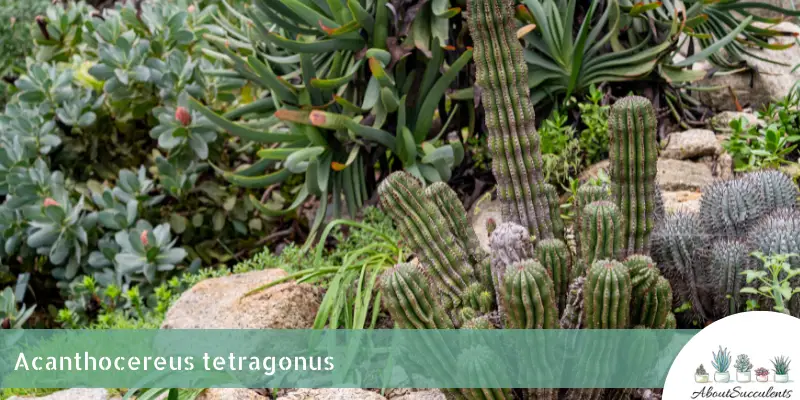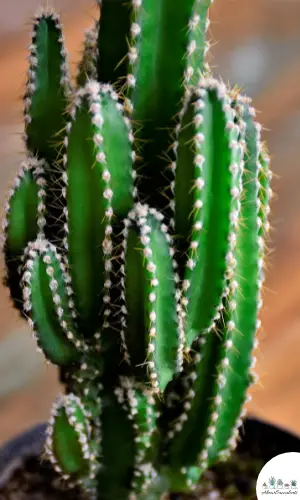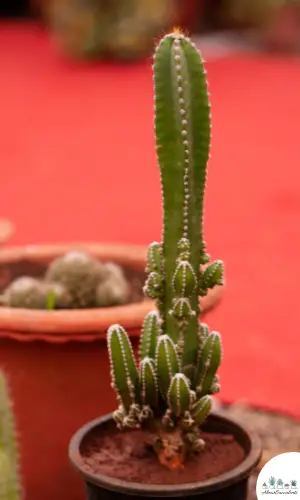
Acanthocereus tetragonus is a mesmerizing succulent that’s easily identified by its columnar green branches that seemingly grow in the hundreds.
These branches clump together as they move vertically and form what resembles the turrets of a castle. Thus, the succulent goes by the aliases “Fairy Castle Cactus”. Other names for this plant are “Triangle Cactus”, “Barbed Wire Cactus”, and “Chaco”.
The stalk of Fairy Castle Cactus has 5 sides that have white spines growing alongside the ribs. This is a type of succulent that hardly blooms. If it does, you will have white or yellow-colored flowers in the summertime.
For those who want to grow the miniature cactus indoors, be advised that it can reach a height of 1.8m (6’).
Acanthocereus tetragonus is native to Florida and the Lower Rio Grande Valley of Texas, Mexico, Central America, the Caribbean, and Northern South America and is a member of the Cactaceae family.
General Information:
Also known as: Fairy Castle Cactus, Triangle Cactus, Barbed Wire Cactus, and Chaco.
Plant Family: Cactaceae
Origin: Florida and the Lower Rio Grande Valley of Texas, Mexico, Central America, the Caribbean, and Northern South America.
Height: 1.8m (6’)
Exposure: Full or partial sun for up to 6 hours.
Water Needs: The soak and dry method is recommended where the soil is given a thorough watering only when it’s been certified as stone dry.
Soil Type: Well-draining and aerated soil such as standard potting mix or cactus with added ingredients like pumice, perlite, gravel, and sand for improved drainage.
Soil pH: 6.0 to 7.5
How to Grow and Care for Acanthocereus Tetragonus

Acanthocereus tetragonus can be part of a first-time horticulturist’s “Starter Pack” as it’s easy to grow and care for.
Fairy Castle Cactus is one of the most popularly bought succulent plants for the indoors. It’s resilient to changes in weather conditions and durable enough that you don’t have to spend too much time taking care of it.
Sunlight
Acanthocereus tetragonus needs regular exposure to sunlight. If you want to grow Triangle Cactus outdoors, plant it in a location where it can get 6 hours of partial to full sunlight.
Fairy Castle Cactus becomes dormant in the wintertime so it won’t require as much sunlight.
Although a durable succulent, Acanthocereus tetragonus is not cold-hardy. It would be best to plant the succulent in a pot that you can transfer indoors should temperatures drop below -1.1° C (30° F).
As an indoor succulent, place the miniature cactus near a window that gets 4 to 6 hours of partial or full sunlight per day.
Watering
Typical of succulent plants of this family, the best way to water Acanthocereus tetragonus is when the soil has been tested and confirmed as completely dry. There are 2 ways you can do this.
First, if the soil feels dry to the touch, then it’s a sign that it needs water. Second, a more accurate method would be to insert a stick 1-2” into the soil. If the end of the stick feels dry, then it’s ready for watering.
There are 2 rules to keep in mind when watering your plants:
- Water the soil and not from above. Watering the plant directly will retain moisture longer. If the succulent has a fungal disease, the water might carry it to the other plants.
- Always give the soil a thorough soaking. If the plant is in a pot, you know you’ve given it a good soaking if excess water starts spilling out of the drain hole.
Pot and Soil
Select a pot that allows proper evaporation of water from the soil. The ideal pot for Acanthocereus tetragonus is one that is made of terracotta or ceramic material.
Get a pot that is large enough to allow the roots of Fairy Castle Cactus to grow and for air to properly circulate through the soil.
Lastly, make sure the pot has a large enough drain hole with a mesh net cover at the bottom.
Barbed Wire Cactus is known to be a resilient succulent that can grow even in poor quality soil.
To ensure maximal growth and health, use well-draining and aerated soil for this cactus and add ingredients such as standard potting mix or cactus with added ingredients like pumice, perlite, gravel, and sand for improved drainage.
How to Propagate Acanthocereus Tetragonus

Another reason why Acanthocereus Tetragonus is a good succulent for beginners to start out with is that it’s easy to propagate. There are 2 methods that you can use: through cuttings or with seeds.
Method 1: Cuttings
Step 1: Cut off a healthy stem from the main plant with the use of a sterilized and sharpened pair of garden shears.
Step 2: Place the cuttings in a dry area for 2-3 days so they can develop hard calluses.
Step 3: When the cuttings have callused over, plant them on well-draining soil.
Step 4: Keep the soil lightly moistened by misting it every day until the roots have taken a firm hold.
Step 5: Once the cuttings have taken root in the soil, only give it water when the soil is 100% dry.
Method 2: Seeds
Step 1: Buy good quality seeds from a reputable garden store.
Step 2: Plant the seeds in well-draining soil.
Step 3: Mist the soil to keep the soil slightly moist.
Step 4: Place a plastic cover over the seeds and locate the pot near an area that gets indirect or partial sunlight. This will initiate the germination process.
Step 5: When you see the seeds sprouting, remove the plastic cover. Water the soil when it’s completely dry.
Frequently Asked Questions
Is Acanthocereus Tetragonus Toxic to Cats and Dogs?
Acanthocereus tetragonus is not listed as a plant that’s toxic to cats and dogs on the website of the American Society for the Prevention of Cruelty to Animals (ASPCA).
Why Is My Acanthocereus Tetragonus Dying?
If your Acanthocereus tetragonus is dying, the number one suspect is overwatering. The other possibility could be that Fairy Castle Cactus has been infested with disease-causing pests.
Overwatering
Did you notice the leaves of Triangle Cactus developing a blackish, yellowish color? If so, this is a sign that a fungal infection has been spreading. The starting point of the infection is the roots.
Overwatering leads to root rotting because the cells of the roots get filled out with so much water that they rupture. This is why you only water the soil when it’s 100% dry.
When you notice discoloration, cut off these parts right away with a sterilized and sharpened knife or garden scissors. Then, remove the plant from the soil so you can examine its roots.
Cut off all rotten roots and allow the plant to dry out. Fill out a ceramic or terracotta pot with fresh, well-draining soil and plant Barbed Wire Cactus in its new home.
Pest Infestation
Insects such as mealybugs, spider mites, scale insects, and aphids are on the lookout for succulent plants such as Acanthocereus tetragonus to drink its sap. When the plant is drained of sap, it slowly begins to wither and grow weak.
These insects also leave white, cotton-like substances on the leaves that can be a source of fungal infection.
To keep these pests away from Triangle Cactus, spray it with neem oil. You can remove the substances from the leaves by wiping them off with a cotton ball that’s soaked in 70% isopropyl alcohol or disinfectant soap.
Does Acanthocereus Tetragonus Produce Flowers?
Acanthocereus tetragonus hardly blooms. But when it does, it will produce white or yellow-colored flowers in the summer.
Last Updated on June 9, 2022 by Sofia Lara